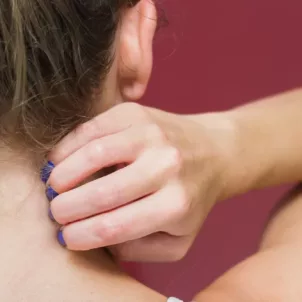Before we dive right into the skin-gut connection, let’s get to know our skin and gut as individuals a little better.
The Skin
Your skin is the largest organ of your body. It’s the first defense barrier against the physical, chemical, and bacterial challenges in the environment. Your skin is home to millions of bacteria. In the right balance, these bacteria can maintain the overall health of your skin. But if it’s out of balance, you’ll start to experience some issues.
The Gut
Your digestive tract is also home to bacteria and other microorganisms. There are trillions of these microorganisms living in your gut that help keep your system working properly. The bacteria are important for helping to digest food, produce vitamins, regulate hormones, and excrete toxins among many other things to keep your gut healthy. Your immunity, stress response, sleep, mood, behavior, metabolism, weight, hormones, and skin health all depend on the health of your gut.
The Gut-Skin Axis
When the integrity of the gut and balance of bacteria gets disturbed, it can have a huge impact on your skin. This connection between the gut and skin is commonly referred to as the gut-skin axis.
Why are these two so closely intertwined? Bacteria and bacteria byproducts interact with your immune system, metabolism, and endocrine pathways. When this system is compromised, it creates stress-related responses in the skin through the gut-skin axis. The bacteria in the gut can then impact things like skin cell turnover and different skin conditions including rosacea, dermatitis, and acne.
In fact, scientists have been aware of this connection since the 1930s. Since then, plenty of modern research confirms the clear association between gut problems and skin disorders. Here are just a few of the many studies that demonstrate the gut-skin axis.
Rosacea
One study reports small intestine bacterial overgrowth (SIBO) is 10 times more prevalent in people with rosacea than in healthy controls. Also, after treating SIBO in the study, skin lesions cleared in almost all participants. Impressive!
Dermatitis
Similarly, celiac disease can also show up with skin symptoms such as dermatitis herpetiformis. This itchy skin rash made up of bumps and blisters occurs in 10 to 15 percent of celiac sufferers. It can happen when those with celiac consume gluten. The mucosal immune system in the intestine responds by producing immunoglobulin A (IgA) antibodies. These IgA antibodies are directed and bind to the epidermal transglutaminase protein, which then triggers the skin reaction.
Acne
As a final example, approximately 85 percent of people between the ages of 12 to 25 have acne. Interestingly, there’s a higher prevalence of acne in Western countries. Why? It may be linked to the high glycemic load of carbohydrates in the typical Western diet. A high glycemic load promotes an increase in insulin-like growth factor (IGF-1). Acne severity has been linked to IGF-1 levels in female acne patients. The research shows that IGF-1 is involved in acne development through upregulating inflammatory biomarkers in the skin’s sebaceous glands.
Understanding Dysbiosis
Experts refer to an imbalance of the gut microbiome as “dysbiosis.” It can cause your immune system to suffer and also increase skin inflammation. Here’s why: Your gut microbiota regulates cell proliferation, lipid metabolism, and other metabolic functions. Your intracellular signaling pathways mediate all of these important processes. However, in cases of dysbiosis, this pathway causes inflammation.
A number of factors can impact your microbiome balance. Diet is a major culprit. Processed foods, sugar, alcohol, low fiber, and GMOs can all negatively impact your microbiome. Notoriously, taking antibiotics depletes good gut bacteria alongside the bad bacteria. However, it’s important to recognize that non-ingestible factors are equally important. Stress, sleep, and environmental toxins are also all culprits for disturbing the gut-skin axis.
How To Care for Your Gut
If you want to optimize your skin’s appearance, it’s essential to focus on your gut health. Maintaining a healthy gut can give your skin that clear, radiant glow. Focus on getting a fiber-rich diet with quality protein and healthy fats to support your gut microbiome. Research also shows that eating a wide variety of fresh produce can improve the diversity of your gut bacteria.
Still, eating well isn’t always enough. Because there are so many factors that can throw off the delicate balance of our microbiome, we often need extra support. Here’s where probiotics come in! Using quality probiotics is one way to help balance your gut bacteria, and in turn, restore healthy skin.
PROBIOTICS
Probiotics are live microorganisms that help keep the proper balance of beneficial bacteria in your gut. Some of the most common strains of probiotics that are beneficial for the skin include those from the lactobacillus and bifidobacterium genera.
In a study as far back as 1961, out of 300 acne patients, 80 percent showed clinical improvement after using probiotics. Strains of probiotics work through the gut-skin axis by having antimicrobial effects, reducing inflammation, and boosting the immune system. They can also help reduce oxidative stress. As a result, recent studies show dramatically improved skin health when consuming probiotics.
In addition to probiotics, prebiotics are also a key player in a healthy gut. Think of prebiotics as food for the probiotics in your intestinal tract. Prebiotic foods are rich in fibers that your gut bacteria ferment. These include bananas, onions, garlic, Jerusalem artichoke, apple skins, beans, chicory root, and konjac root.
The Bottom Line
Research is clear about the connection between your gut health and the appearance of your skin. While the foods we eat and hydration all play essential roles, the balance of the microorganisms in our gut are also hugely important for healthy skin. In order to keep your gut bacteria healthy for clear skin, be sure to eat a diverse diet and supplement with pre and probiotics to keep the gut-skin axis in balance.










